This section explains how to develop CORBA server applications.
Contents of Program Created
In this tutorial, you will create the following type of program:
Binary program
This program performs arithmetic operations with two parameters.
Methods named addop, subop, mltop, and divop are used for addition, subtraction, multiplication, and division, respectively.
Without returning a return value, each method places the parameters in a structured format and sets result of the operation into the structure so that clients can refer to it. (The parameter mode must be inout because the parameters are specified by a client and each result of the operation is set by a server application.)
Each of the multiplication and division methods checks the parameters and, if one of them is 0, returns an exception.
Developing procedure
This section explains how to develop CORBA server applications.
1. Starting the Interstage basis service
1. Starting the Interstage basis service
Before creating CORBA applications, it is necessary to start the J2EE execution environment service . Because the J2EE execution environment service is not started by default, use the Interstage basis service operation tool to start the service. Refer to "Checking the environment settings of Interstage Application Server".
2. Creating a CORBA Server Project
Start the Interstage Studio Workbench.
If the COBOL perspective is not displayed, then follow the procedure below to display it:
Select "Window" > "Open Perspective" > "Other" from the menu bar. The "Open Perspective" dialog box is displayed.
Select "COBOL", then click the "OK" button.
Select "File" > "New" > "CORBA Server Project" from the workbench - a new CORBA Server project is displayed.
Enter the project name and the save folder.
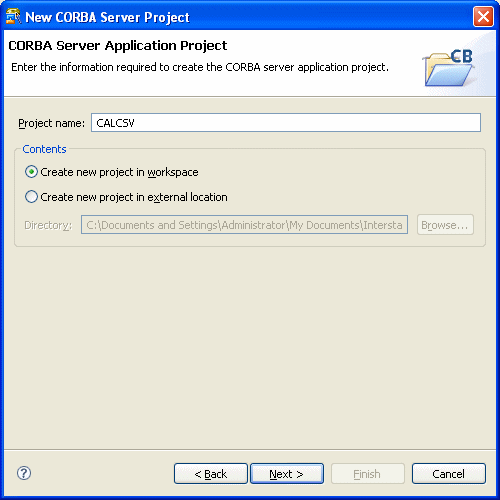
Setting item | Setting value |
|---|---|
Project name | CALCSV |
Contents | Select "Create new project in workspace" |
Click the "Next" button.
You can specify the target information on this screen. Proceed without specifying any changes here.
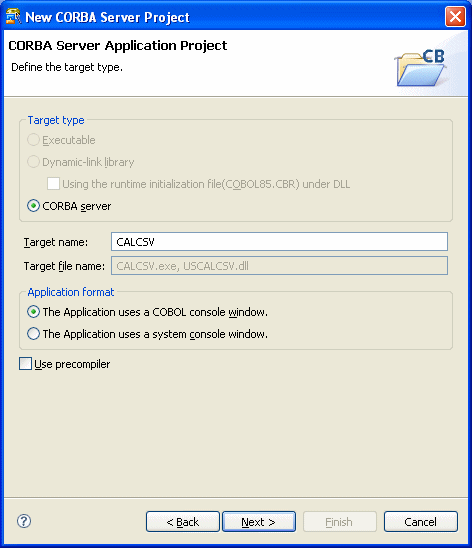
Click the "Next" button.
You can specify the target information on this screen. Proceed without specifying any changes here.
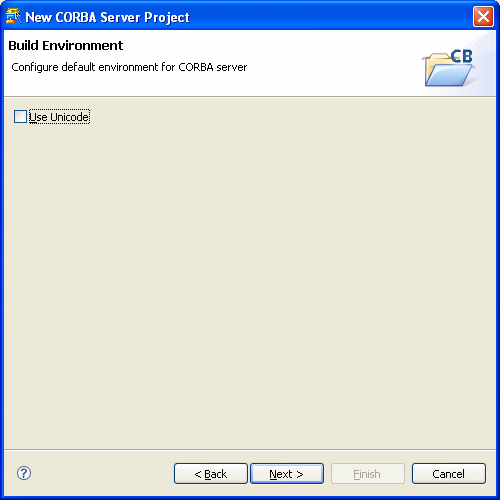
Click the "Next" button.
You can select the option "Generate code". Make sure that "CORBA server application" is selected as the code generation wizard, and click the "Finish" button
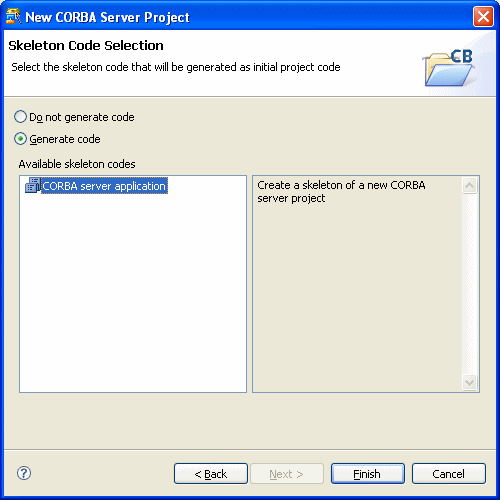
The "New CORBA Server Application Skeleton Code wizard" is started after the project is created.
On this screen, specify the following settings. Click the "Next" button.
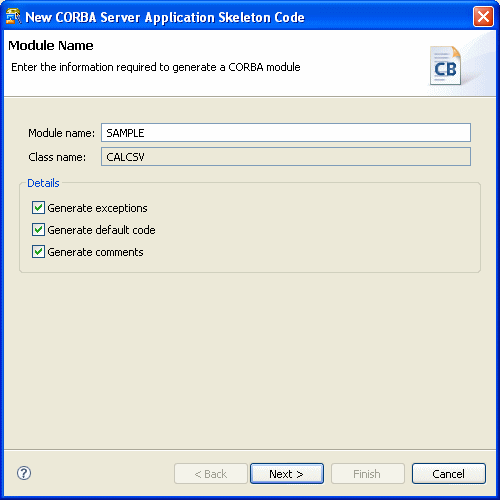
Setting item | Setting value |
|---|---|
Module name | SAMPLE(any) |
Class name | CALCSV(project name, fixed) |
Generate exceptions(*1) | Check |
Generate default code (*2) | Check |
Generate comments (*3) | Check |
*1: For multiplication and division exception, check "Generate exceptions". If it is checked, the following exception declaration is generated in IDL.
exception CDException{
string CDExceptionMsg;
long CDExceptionCode;
};*2: If "Generate default code" is checked, a definition of a method to be implemented as a server application and the code for that method is generated. Otherwise, only a method declaration is generated.
*3: If "Generate default code" is checked, a definition of a method to be implemented as a server application and the code for that method is generated. Otherwise, only a method declaration is generated. If "Generate comments" is checked, a comment is generated in the template source created.
On this second screen, you can declare constants. In this tutorial, define two constants in such a way that exceptions are generated and error messages are thrown. Click the "Next" button.
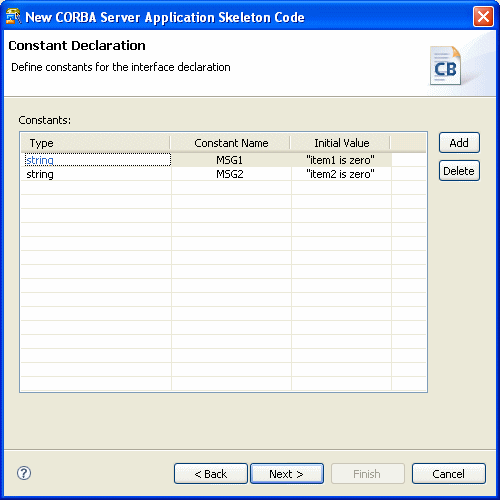
Constant1
Setting item | Setting value |
|---|---|
Type | string |
Constant name | MSG1 |
Initial value | "item1 is zero" |
Constant2
Setting item | Setting value |
|---|---|
Type | string |
Constant name | MSG2 |
Initial value | "item2 is zero" |
On this screen make a type declaration. Here, you can define repetition items, but no such definition is required in this tutorial.
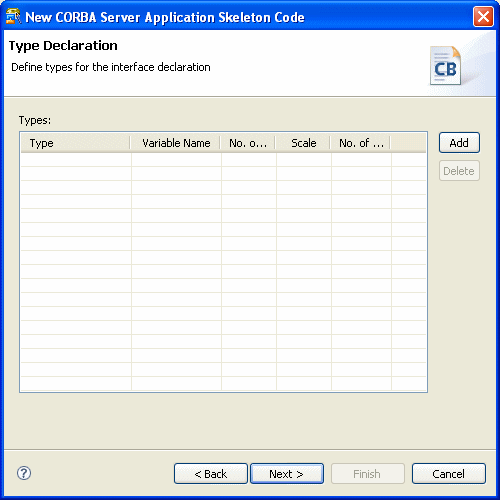
Proceed without making any changes on this screen. Click the "Next" button.
Here, you can declare a structure. This sample program requires two input areas from a client and one area for results of operation. Declare these areas as one structure.
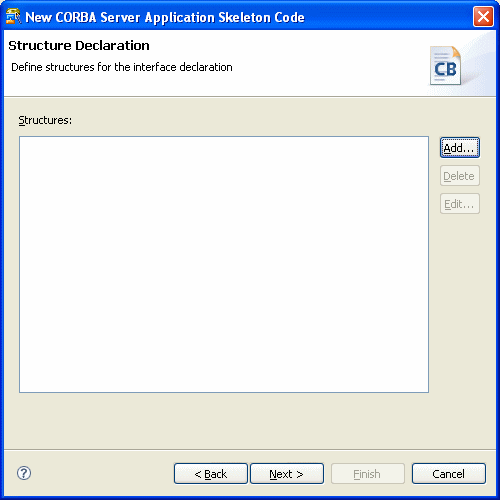
On this screen, click the" Add" button to display the Structure Definition dialog, and declare the structure in this dialog.
Here, declare the structure "S1", which consists of the following members.
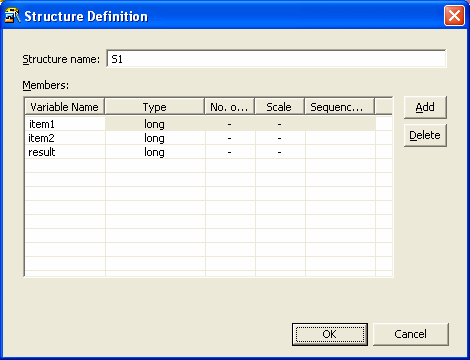
Variable name | Type | Usage |
|---|---|---|
item1 | long | Item used for a binary operation (its value is specified by a client) |
item2 | long | Item used for a binary operation (its value is specified by a client) |
result | long | Result of a binary operation (its value is set by the server) |
Click the "OK" button, "S1" is displayed on the "Structure Declaration" page.
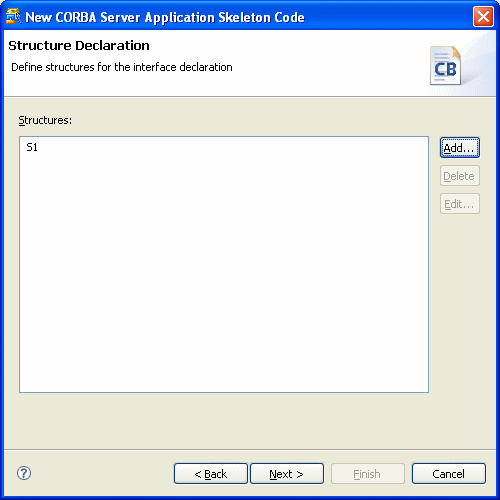
Click the "Next" button.
Next, declare business methods. Here, declare the addop, subop, mltop, and divop methods described in "Contents of Program Created".
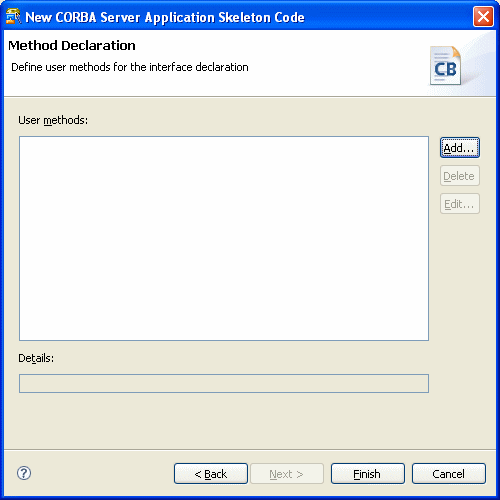
On this screen, click the "Add" button to display the "User Method Definition" dialog, and declare the methods in this dialog.
The addop method settings are specified in the dialog as shown below.
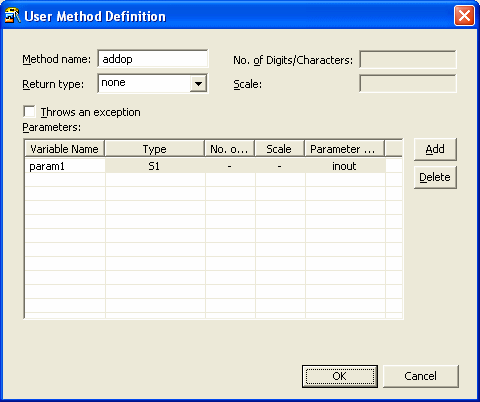
The following are specified.
addop method
Setting item | Setting value |
|---|---|
Method name | addop |
Return type | none(void) |
Throws an exception | Uncheck |
Parameters | Variable Name : param1 |
subop method
Setting item | Setting value |
|---|---|
Method name | subop |
Return type | none(void) |
Throws an exception | Uncheck |
Parameters | Variable Name : param1 |
mltop method
Setting item | Setting value |
|---|---|
Method name | mltop |
Return type | none(void) |
Throws an exception | Check(*3) |
Parameters | Variable Name : param1 |
divop method
Setting item | Setting value |
|---|---|
Method name | divop |
Return type | none(void) |
Throws an exception | Check (*3) |
Parameters | Variable Name : param1 |
(*1) "S1" is the structure name declared in the structure definition.
(*2) Specify "inout" as the parameter type for the "S1" structure as values are set by both server and client applications.
(*3) Enable "Throws an exception" for multiplication and division methods.
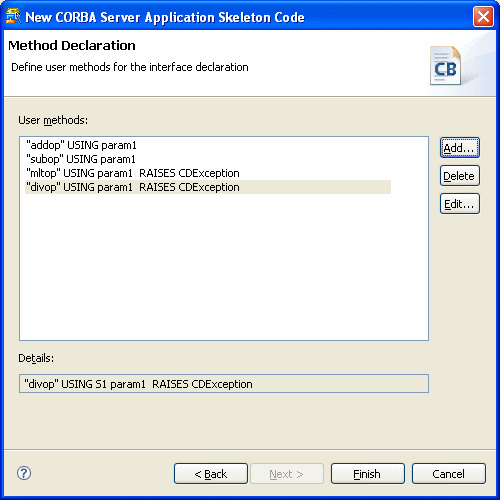
Click the "Finish" button. When "Finish" button is clicked, template sources are created in the source file folder. In this tutorial, the following files are generated.
File name | Description |
|---|---|
CALCSV.cob | Main source program (server application framework) |
SAMPLE-CALCSV-IMPL.cob | Business method program |
SAMPLE-CALCSV--INIT.cob | Server application registration program |
USCALCSV.idl | Interface file (IDL file) |
COBOL source file beginning with "SAMPLE" | Skeleton file created by IDL compiler |
3. Editing Programs
// Module declaration
module SAMPLE {
// Constant declaration
const string MSG1 = "item1 is zero" ;
const string MSG2 = "item2 is zero" ;
// Type declaration
// Structure declaration
struct S1 {
long item1;
long item2;
long result;
};
// Exception declaration
exception CDException{
string CDExceptionMsg;
long CDExceptionCode;
};
// User interface declaration
interface CALCSV {
void addop(inout S1 param1);
void subop(inout S1 param1);
void mltop(inout S1 param1)
raises (CDException);
void divop(inout S1 param1)
raises (CDException);
};
};You can edit the IDL file as per requirement, but no such editing is required in this tutorial.
* If interface information is modified, be sure to also modify the business method program source so that they are consistent with each other.
000010 IDENTIFICATION DIVISION. 000020 PROGRAM-ID. CALCSV. 000030 ENVIRONMENT DIVISION. 000040 CONFIGURATION SECTION. 000050 REPOSITORY. 000060 COPY CORBA--REP. 000070 COPY USCALCSV--REP. 000080 . 000090 SPECIAL-NAMES. 000100 SYMBOLIC CONSTANT 000110 COPY CORBA--CONST. 000120 . 000130 DATA DIVISION. 000140 WORKING-STORAGE SECTION. 000150 COPY CORBA--COPY. 000160 COPY USCALCSV--COPY. 000170 01 API-NAME PIC X(50). 000180 01 APL-NAME PIC X(64) VALUE "CALCSV". 000190 01 ORB USAGE OBJECT REFERENCE CORBA-ORB. 000200 01 BOA USAGE OBJECT REFERENCE CORBA-BOA. 000210 01 IMPL-REP USAGE OBJECT REFERENCE FJ-IMPLEMENTATIONREP. 000220 01 IMPL USAGE OBJECT REFERENCE CORBA-IMPLEMENTATIONDEF. 000230 01 REP-ID PIC X(128) VALUE "IDL:SAMPLE/CALCSV:1.0".(*1) 000240 01 OBJ USAGE OBJECT REFERENCE CORBA-OBJECT. 000250 01 EXCEPT-ID USAGE OBJECT REFERENCE CORBA-STRING. 000260 01 EXCEPT-ID-VALUE PIC X(50). 000270 LINKAGE SECTION. 000280 PROCEDURE DIVISION 000290 . 000300* 000310* ORB initialization 000320* 000330 INVOKE CORBA "ORB_INIT" USING APL-NAME FJ-OM_ORBID RETURNING ORB. 000340* 000350* BOA initialization 000360* 000370 INVOKE ORB "BOA_INIT" USING APL-NAME CORBA-BOA_OAID RETURNING BOA. 000380* 000390* Obtain the implementation object repository. 000400* 000410 INVOKE ORB "RESOLVE_INITIAL_REFERENCES" USING 000411 CORBA-OBJECTID_IMPLEMENTAT-001 RETURNING OBJ. 000420 INVOKE FJ-IMPLEMENTATIONREP "NARROW" USING OBJ RETURNING IMPL-REP. 000430* 000440* Obtain implementation information. 000450* 000460 INVOKE IMPL-REP "LOOKUP_ID" USING REP-ID RETURNING OBJ. 000470 INVOKE CORBA-IMPLEMENTATIONDEF "NARROW" USING OBJ RETURNING IMPL. 000480* 000490 SET OBJ TO NULL. 000500* 000510* Notify the OD of server activation. 000520* 000530 MOVE "CORBA::BOA::IMPL_IS_READY" TO API-NAME. 000540 INVOKE BOA "IMPL_IS_READY" USING IMPL. 000550* 000560 STOP RUN. 000570 END PROGRAM CALCSV.
(*1) Repository ID
Each CORBA server application is determined by a unique repository ID. The default ID is "IDL:module-name/interface-name:1.0". For details, refer to the Interstage Application Server manuals.
This program registers the server application so that it can be used as a CORBA server. No modification is required.
000010 IDENTIFICATION DIVISION. 000020 PROGRAM-ID. SAMPLE-CALCSV--INIT. 000030 ENVIRONMENT DIVISION. 000040 CONFIGURATION SECTION. 000050 REPOSITORY. 000060 CLASS SAMPLE-CALCSV 000070 CLASS SAMPLE-CALCSV-IMPL 000080 . 000090 DATA DIVISION. 000100 WORKING-STORAGE SECTION. 000110 LINKAGE SECTION. 000120 01 RET USAGE OBJECT REFERENCE SAMPLE-CALCSV. 000130 PROCEDURE DIVISION 000140 RETURNING RET 000150 . 000160 INVOKE SAMPLE-CALCSV-impl "new" RETURNING RET. 000170 EXIT PROGRAM. 000180 END PROGRAM SAMPLE-CALCSV--INIT.
The addop, subop, mltop, and divop methods entered in the wizard are declared. Implement their processes.
Add the statements shown in blue.
000010 CLASS-ID. SAMPLE-CALCSV-IMPL AS "SAMPLE-CALCSV-IMPL" INHERITS 000020 SAMPLE-CALCSV 000030 . 000040 ENVIRONMENT DIVISION. 000050 CONFIGURATION SECTION. 000060 REPOSITORY. 000070 COPY CORBA--REP. 000080 COPY USCALCSV--REP. 000090 . 000100 SPECIAL-NAMES. 000110 SYMBOLIC CONSTANT 000120 COPY CORBA--CONST. 000121 COPY USCALCSV--CONST. 000130 . 000140 OBJECT. 000150 DATA DIVISION. 000160 WORKING-STORAGE SECTION. 000170 COPY CORBA--COPY. 000180 COPY USCALCSV--COPY. 000190 PROCEDURE DIVISION 000200 . 000210 METHOD-ID. ADDOP AS "ADDOP" OVERRIDE. 000220* <IDL-INFO-START> 000230* void addop(inout S1 param1) 000240* <IDL-INFO-END> 000250 DATA DIVISION. 000260 WORKING-STORAGE SECTION. 000270 LINKAGE SECTION. 000280 01 PARAM1 TYPE SAMPLE-S1. 000290 PROCEDURE DIVISION 000300 USING 000310 PARAM1 000320 . 000321 COMPUTE result OF param1 = item1 OF param1 + item2 OF param1.
000330 END METHOD ADDOP. 000340 METHOD-ID. SUBOP AS "SUBOP" OVERRIDE. 000350* <IDL-INFO-START> 000360* void subop(inout S1 param1) 000370* <IDL-INFO-END> 000380 DATA DIVISION. 000390 WORKING-STORAGE SECTION. 000400 LINKAGE SECTION. 000410 01 PARAM1 TYPE SAMPLE-S1. 000420 PROCEDURE DIVISION 000430 USING 000440 PARAM1 000450 . 000451 COMPUTE result OF param1 = item1 OF param1 - item2 OF param1. 000460 END METHOD SUBOP. 000470 METHOD-ID. MLTOP AS "MLTOP" OVERRIDE. 000480* <IDL-INFO-START> 000490* void mltop(inout S1 param1) 000500* <IDL-INFO-END> 000510 DATA DIVISION. 000520 WORKING-STORAGE SECTION. 000521 01 W-EXCEPTION OBJECT REFERENCE SAMPLE-CDException.
000522 01 W-STRING OBJECT REFERENCE CORBA-STRING.
000530 LINKAGE SECTION. 000540 01 PARAM1 TYPE SAMPLE-S1. 000550 PROCEDURE DIVISION 000560 USING 000570 PARAM1 000580 RAISING 000590 SAMPLE-CDEXCEPTION 000600 . 000601* Exception processing
000602 IF item1 OF param1 = 0
000603 THEN
000604 INVOKE SAMPLE-CDException "NEW" RETURNING W-EXCEPTION
000605 MOVE -1 TO CDEXCEPTIONCODE OF W-EXCEPTION
000606 INVOKE CORBA-STRING "NEW" RETURNING W-STRING
000607 INVOKE W-STRING "SET-VALUE" USING SAMPLE-MSG1
000608 SET CDEXCEPTIONMSG OF W-EXCEPTION TO W-STRING
000609 EXIT METHOD RAISING W-EXCEPTION
000610 END-IF
000611 IF item2 OF param1 = 0
000612 THEN
000613 INVOKE SAMPLE-CDException "NEW" RETURNING W-EXCEPTION
000614 MOVE -1 TO CDEXCEPTIONCODE OF W-EXCEPTION
000615 INVOKE CORBA-STRING "NEW" RETURNING W-STRING
000616 INVOKE W-STRING "SET-VALUE" USING SAMPLE-MSG2
000617 SET CDEXCEPTIONMSG OF W-EXCEPTION TO W-STRING
000618 EXIT METHOD RAISING W-EXCEPTION
000619 END-IF
000620 COMPUTE result OF param1 = item1 OF param1 * item2 OF param1.
000621 000622 END METHOD MLTOP. 000623 METHOD-ID. DIVOP AS "DIVOP" OVERRIDE. 000630* <IDL-INFO-START> 000640* void divop(inout S1 param1) 000650* <IDL-INFO-END> 000660 DATA DIVISION. 000670 WORKING-STORAGE SECTION. 000671 01 W-EXCEPTION OBJECT REFERENCE SAMPLE-CDException.
000672 01 W-STRING OBJECT REFERENCE CORBA-STRING.
000680 LINKAGE SECTION. 000690 01 PARAM1 TYPE SAMPLE-S1. 000700 PROCEDURE DIVISION 000710 USING 000720 PARAM1 000730 RAISING 000740 SAMPLE-CDEXCEPTION 000750 . 000751* Exception processing
000752 IF item1 OF param1 = 0
000753 THEN
000754 INVOKE SAMPLE-CDException "NEW" RETURNING W-EXCEPTION
000755 MOVE -1 TO CDEXCEPTIONCODE OF W-EXCEPTION
000756 INVOKE CORBA-STRING "NEW" RETURNING W-STRING
000757 INVOKE W-STRING "SET-VALUE" USING SAMPLE-MSG1
000758 SET CDEXCEPTIONMSG OF W-EXCEPTION TO W-STRING
000759 EXIT METHOD RAISING W-EXCEPTION
000760 END-IF
000761 IF item2 OF param1 = 0
000762 THEN
000763 INVOKE SAMPLE-CDException "NEW" RETURNING W-EXCEPTION
000764 MOVE -1 TO CDEXCEPTIONCODE OF W-EXCEPTION
000765 INVOKE CORBA-STRING "NEW" RETURNING W-STRING
000766 INVOKE W-STRING "SET-VALUE" USING SAMPLE-MSG2
000767 SET CDEXCEPTIONMSG OF W-EXCEPTION TO W-STRING
000768 EXIT METHOD RAISING W-EXCEPTION
000769 END-IF
000770 COMPUTE result OF param1 = item1 OF param1 / item2 OF param1.
000771 000772 END METHOD DIVOP. 000773 END OBJECT. 000780 END CLASS SAMPLE-CALCSV-IMPL.
Point
The "S1" structure is fixed in length and hence, is accompanied by a TYPE declaration.
Elements of the "S1" structure are defined as group items and therefore can be used as group items.
To report an exception, generate (new) an exception class instance, and specify a value in the member.
4. Building the Project
Select "Save" from the context menu of the edit window in USCALCSV.cob and the CORBA server application is built automatically.
However, if "Project" > "Build Automatically" was not previously selected (the "Build Automatically" menu item will have a check if it was selected), the application is not built.
Select the CORBA server project in the Dependency View or Structure View, and select "Project" > "Project Build" from the menu bar to build the CORBA server project.
5. Running the Program
The CORBA server application runs on a WorkUnit. This section explains the general procedure for verifying the operation of CORBA server application.
Point
Note on MyCORBADebug
In the initial state, a WorkUnit named MyCORBADebug is created for debugging. This created MyCORBADebug can be used as the deployment destination for functional tests. For details, see "11.5.1.4.3 Creating the CORBA work Unit".
Copying runtime resources
Copy the execution file and dynamic link library to the runtime environment, both of which have been generated during building.
In this tutorial, copy the following files to the following destination:
File: CALCSV.exe, USCALCSV.dll Copy destination folder: C:\Interstage\APS\var\CORBA_WU\MyCORBADebug
The files can be copied to any folder. In this tutorial, however, they are copied to the default application folder of the WorkUnit to be created.
Making of application operation current directory
Create the application operation current directory that is needed because of the start of the work unit.
Because the default value is used in this tutorial when the work unit is made, it is necessary to prepare the following directories.
C:\Interstage\APS\var\CORBA_WU\MyCORBADebug\work
Deploying the CORBA server application
Click right button on IJServer view, select "Interstage Management Console". When it is not connected to the Interstage Application Server, select "Connect/Login" from the context menu of the Interstage Application Server, connect or log on to the Interstage Application Server and then select "Interstage Management Console". Select the deployment destination WorkUnit from the left tree of the Management Console, and select the "Deploy" tab in the right side of the window.
Specify an implementation repository ID and executable program file name.
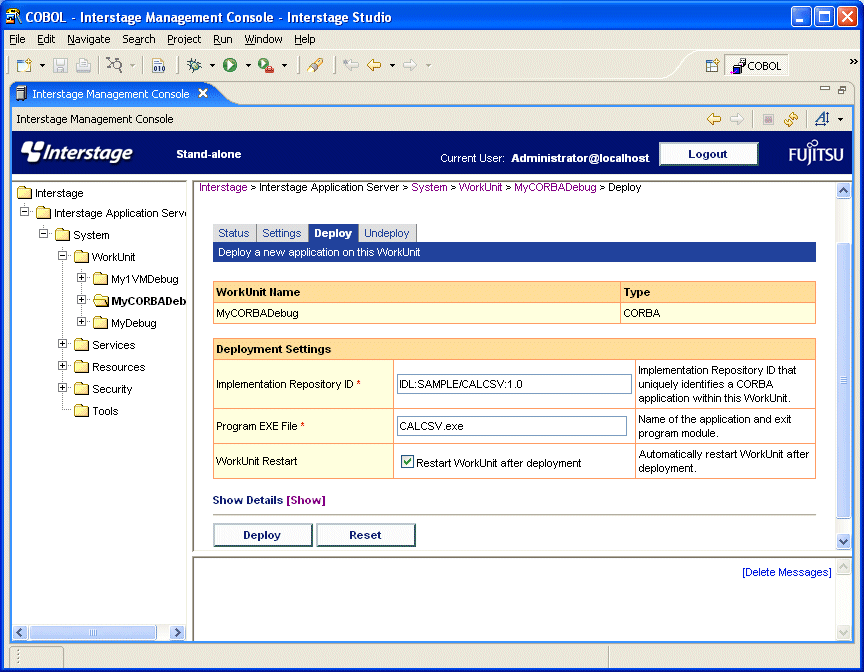
Specify the implementation repository ID in the following format:
IDL:module-name/interface-name:1.0
For the executable program file name, specify the name of the EXE file that was copied.
Click "Show" of the Show Details, then click "Show" of the CORBA application. The Detailed Settings window is displayed. Select "SYNC_END" from the "Operation Mode".
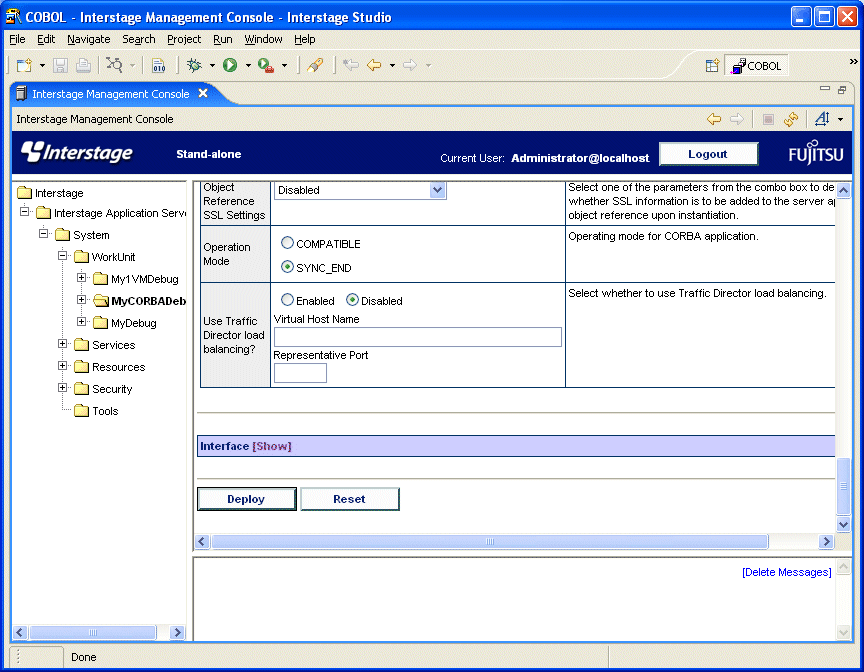
Click "Show" of the Interface. Click the "Add Interface" button, and specify the interface repository ID, naming service registration name, and library name as shown below.
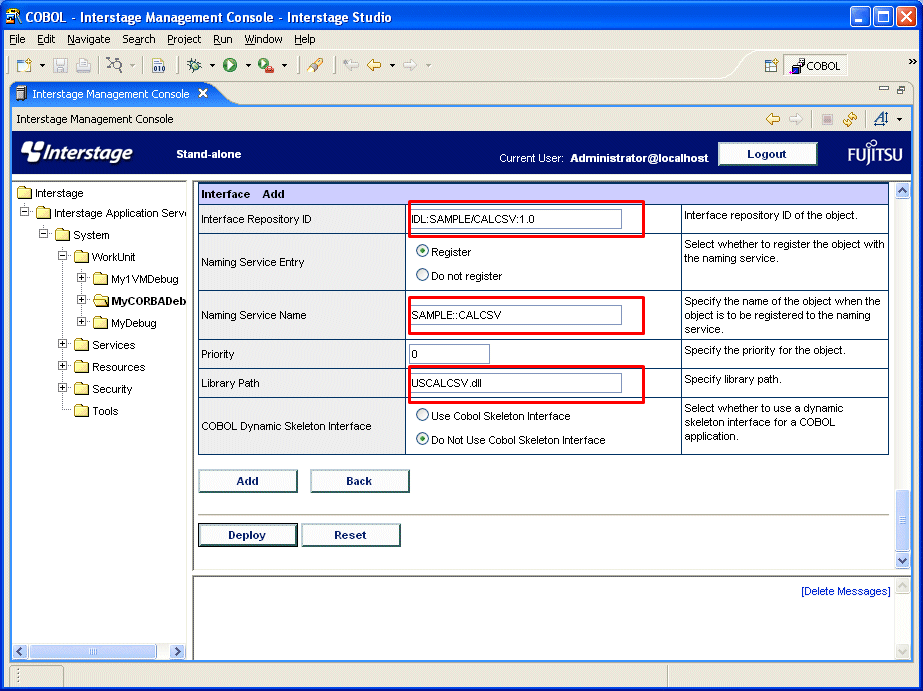
Click the "Add" button, then click the "Deploy" button to execute deployment.
Starting the WorkUnit
If "Restart WorkUnit after deployment" was not selected as the initial setting during deployment, start the created WorkUnit as follows.
Select the WorkUnit from the tree in the view on the left side of the Interstage Management Console, and click the "Status" tab in the right side of the window. Then, click the "Start" button.
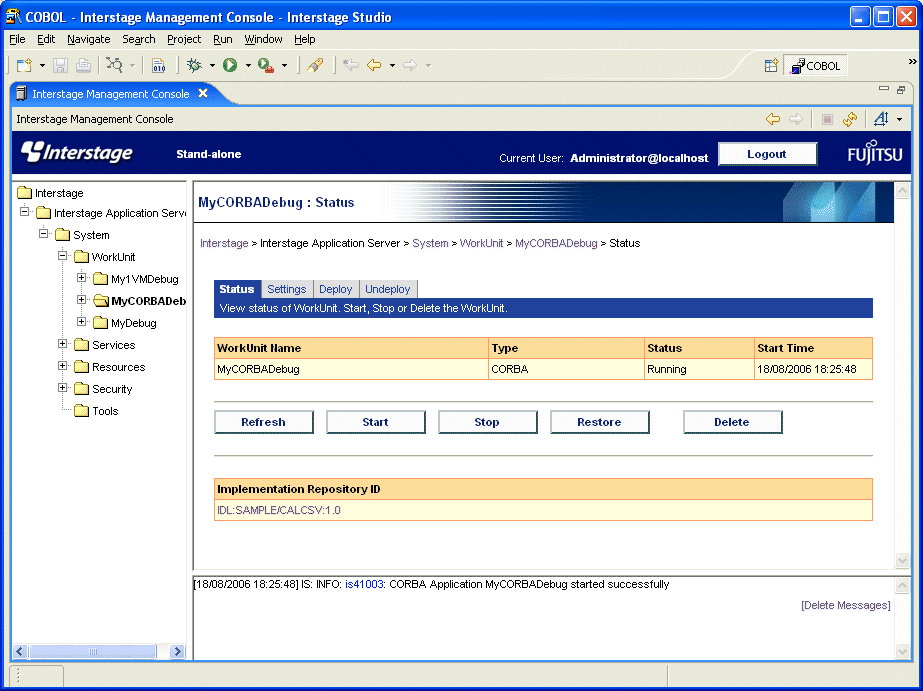
During the startup sequence, if there is no application operation current directory, an error occurs. You can check the application operation current directory by clicking the "Settings" tab of the WorkUnit.
Running a client application
Run a client application that accesses the CORBA server application.
For details on how to create and run a client application, refer to "11.2.3 Developing CORBA Client Applications".